Physics
1. Four point masses, each of mass m, are fixed at the corners of a square of side l. The square is rotating with angular frequency ω, about an axis passing through one of the corners of the square and parallel to its diagonal, as shown in the figure. The angular momentum of the square about this axis is:

(1) 4ml2ω
(2) 2ml2ω
(3) 3ml2ω
(4) ml2ω
2. A screw gauge has 50 divisions on its circular scale. The circular scale is 4 units ahead of the pitch scale marking, prior to use. Upon one complete rotation of the circular scale, a displacement of 0.5mm is noticed on the pitch scale. The nature of zero error involved and the least count of the screw gauge, are respectively:
(1) Positive, 0.1 mm
(2) Positive, 0.1μ m
(3) Positive, 10 μm
(4) Negative, 2 μm
3. An electron, a doubly ionized helium ion (He++) and a proton are having the same kinetic energy. The relation between their respective de-Broglie wavelengths λe, λHe++ and λp is:
(1) λe > λp > λHe++
(2) λe > λHe++ > λp
(3) λe < λp < λHe++
(4) λe < λHe++ = λp
4. For the given input voltage waveform Vin(t), the output voltage waveform Vo(t), across the capacitor is correctly depicted by:


5. Shown in the figure is a hollow ice cream cone (it is open at the top). If its mass is M, the radius of its top, R and height, H, then its moment of inertia about its axis is:
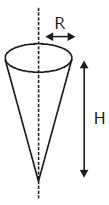
(1) MR2/2
(2) MR2/3
(3) ![]()
(4) MH2/3
6. A satellite is in an elliptical orbit around a planet P. It is observed that the velocity of the satellite when it is farthest from the planet is 6 times less than that when it is closest to the planet. The ratio of distances between the satellite and the planet at closest and farthest points is:
(1) 1 : 2
(2) 1 : 3
(3) 1 : 6
(4) 3 : 4
7. You are given that mass of ![]()
Mass of ![]()
and Mass off ![]()
When 20 g of ![]() is converted into
is converted into ![]() by proton capture, the energy liberated, (in kWh), is: [Mass of nucleon = 1 GeV/c2]
by proton capture, the energy liberated, (in kWh), is: [Mass of nucleon = 1 GeV/c2]
(1) 6.82 × 105
(2) 4.5 × 105
(3) 8 × 106
(4) 1.33 × 106
8. If the potential energy between two molecules is given by ![]() then at equilibrium, the separation between molecules, and the potential energy are:
then at equilibrium, the separation between molecules, and the potential energy are:
(1) 
(2) 
(3) 
(4) 
9. A clock has a continuously moving second’s hand of 0.1 m length. The average acceleration of the tip of the hand (in units of ms–2) is of the order of
(1) 10−3
(2) 10−1
(3) 10−2
(4) 10−4
10. Identify the correct output signal Y in the given combination of gates (as shown) for the given inputs A and B.
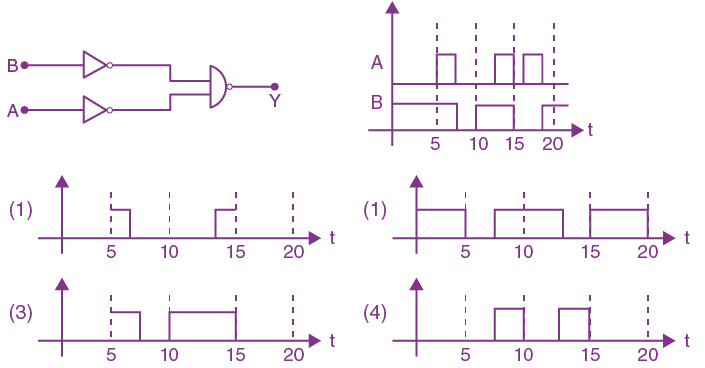
11. An electron is moving along +x direction with a velocity of 6 × 106 ms–1. It enters a region of the uniform electric field of 300 V/cm pointing along +y direction. The magnitude and direction of the magnetic field set up in this region such that the electron keeps moving along the x-direction will be
(1) 3 × 10–4 T, along –z direction
(2) 5 × 10–3 T, along –z direction
(3) 5 × 10–3 T, along +z direction
(4) 3 × 10–4 T, along +z direction
12. In the figure below, P and Q are two equally intense coherent sources emitting radiation of wavelength 20 m. The separation between P and Q is 5 m and the phase of P is ahead of that of Q by 90°. A, B and C are three distinct points of observation, each equidistant from the midpoint of PQ. The intensities of radiation at A, B, C will be in the ratio:

(1) 4 : 1 : 0
(2) 2 : 1 : 0
(3) 0 : 1 : 2
(4) 0 : 1 : 4
13. A point-like object is placed at a distance of 1 m in front of a convex lens of the focal length of 0.5 m. A plane mirror is placed at a distance of 2 m behind the lens. The position and nature of the final image formed by the system are:
(1) 1 m from the mirror, virtual
(2) 2.6 m from the mirror, virtual
(3) 1 m from the mirror, real
(4) 2.6 m from the mirror, real
14. An insect is at the bottom of a hemispherical ditch of radius 1 m. It crawls up the ditch but starts slipping after it is at height h from the bottom. If the coefficient of friction between the ground and the insect is 0.75, then h is: (g = 10 ms–2)
(1) 0.45 m
(2) 0.60 m
(3) 0.20 m
(4) 0.80 m
15. Molecules of an ideal gas are known to have three translational degrees of freedom and two rotational degrees of freedom. The gas is maintained at a temperature of T. The total internal energy, U of a mole of this gas, and the value of  are given, respectively by:
are given, respectively by:
(1) ![]()
(2) ![]()
(3) ![]()
(4) ![]()
16. An object of mass m is suspended at the end of a massless wire of length L and area of cross-section A. Young modulus of the material of the wire is Y. If the mass is pulled down slightly its frequency of oscillation along the vertical direction is:
(1) ![]()
(2) ![]()
(3) ![]()
(4) ![]()
17. An AC circuit has R = 100Ω, C = 2μF and L = 80 mH, connected in series. The quality factor of the circuit is:
(1) 20
(2) 2
(3) 0.5
(4) 400
18. Charges Q1 and Q2 are at points A and B of a right angle triangle OAB (see figure). The resultant electric field at point O is perpendicular to the hypotenuse, then Q1/Q2 is proportional to:
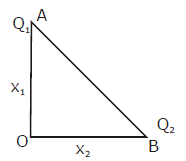
(1) ![]()
(2) ![]()
(3) ![]()
(4) ![]()
19. A sound source S is moving along a straight track with speed v, and is emitting, the sound of frequency vO (see figure). An observer is standing at a finite distance, at the point O, from the track. The time variation of frequency heard by the observer is best represented by (t0 represents the instant when the distance between the source and observer is minimum)
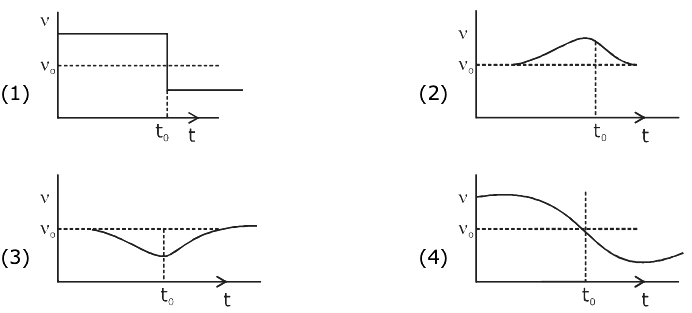
20. A particle of charge q and mass m is moving with velocity –vi (v ≠ 0) towards a large screen placed in the Y-Z plane at a distance d. If there is a magnetic field B = B0k, the minimum value of v for which the particle will not hit the screen is:
(1) qdB0/m
(2) qdB0/3m
(3) 2qdB0/m
(4) qdB0/2m
21. Two bodies of the same mass are moving with the same speed, but in different directions in a plane. They have a completely inelastic collision and move together thereafter with a final speed which is half of their initial speed. The angle between the initial velocities of the two bodies (in degree) is ________.
22. Suppose that intensity of a laser is  The rms electric field, in units of V/m associated with this source is close to the nearest integer is __________. (∈0 = 8.86 × 10–12 C2Nm–2; c = 3 × 108 ms–1)
The rms electric field, in units of V/m associated with this source is close to the nearest integer is __________. (∈0 = 8.86 × 10–12 C2Nm–2; c = 3 × 108 ms–1)
23. The density of a solid metal sphere is determined by measuring its mass and its diameter. The maximum error in the density of the sphere is ![]() If the relative errors in measuring the mass and the diameter are 6.0% and 1.5% respectively, the value of x is_______.
If the relative errors in measuring the mass and the diameter are 6.0% and 1.5% respectively, the value of x is_______.
24. Initially a gas of diatomic molecules are contained in a cylinder of volume V1 at a pressure P1 and temperature 250 K. Assuming that 25% of the molecules get dissociated causing a change in the number of moles. The pressure of the resulting gas at temperature 2000 K, when contained in a volume 2V1 is given by P2. The ratio P2/P1 is ________.
25. A part of a complete circuit is shown in the figure. At some instant, the value of current I is 1A and it is decreasing at a rate of 102 As–1. The value of the potential difference VP – VQ, (in volts) at that instant, is _________.

Chemistry
1. The INCORRECT statement is:
(1) Cast iron is used to manufacture wrought iron.
(2) Brass is an alloy of copper and nickel.
(3) German silver is an alloy of zinc, copper and nickel.
(4) Bronze is an alloy of copper and tin
2. The species that has a spin-only magnetic moment of 5.9 BM, is: (Td= tetrahedral)
(1) [Ni(CN)4]2− (square planar)
(2) Ni(CO)4(Td)
(3) [MnBr4]2−(Td)
(4) [NiCl4]2−(Td)
3. For the reaction ![]()
(1) Kc = Kp(RT)1/2
(2) Kc = Kp(RT)−1/2
(3) Kc = Kp(RT)3/2
(4) Kc = Kp (RT)
4. Consider the following reactions:

A is:

5. Arrange the following solutions in the decreasing order of pOH:
(A) 0.01 M HCl
(B) 0.01 M NaOH
(C) 0.01 M CH3COONa
(D) 0.01 M NaCl
(1) (A) > (C) > (D) > (B)
(2) (B) > (D) > (C) > (A)
(3) (B) > (C) > (D) > (A)
(4) (A) > (D) > (C) > (B)
6. The variation of equilibrium constant with temperature is given below :
Temperature Equilibrium Constant
T1= 25°C K1= 10
T2= 100°C K2= 100
The value of ∆H°, ∆G° at T1 and ∆G° at T2 (in Kj mol−1) respectively, are close to
[use R = 8.314JK−1 mol−1]
(1) 28.4, −7.14 and −5.71
(2) 0.64, −7.14 and −5.71
(3) 28.4, −5.71 and −14.29
(4) 0.64, −5.71 and −14.29
7. Consider the following reactions
A→ P1; B→ P2; C→ P3; D →P4,
The order of the above reactions are a, b, c and d, respectively. The following graph is obtained when log[rate] vs. log[conc.] are plotted.
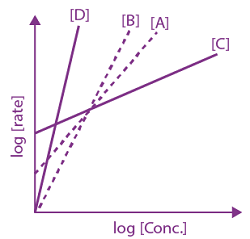
Among the following the correct sequence for the order of the reactions is:
(1) c > a > b > d
(2) d > a > b > c
(3) d > b > a > c
(4) a > b > c > d
8. The major product obtained from the following reactions is:
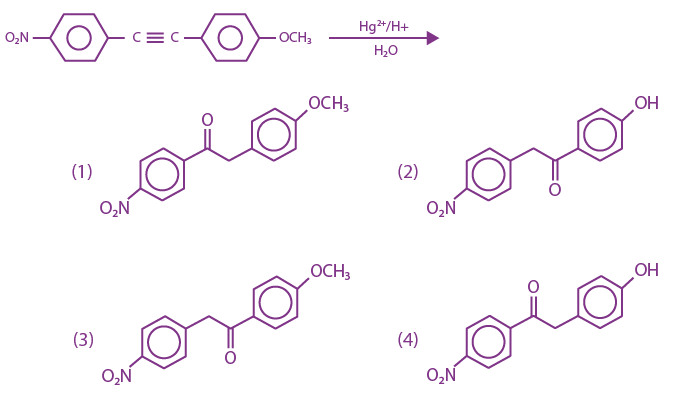
9. Which of the following compounds shows geometrical isomerism?
(1) 2-methylpent-1-ene
(2) 4-methylpent-2-ene
(3) 2-methylpent-2-ene
(4) 4-methylpent-1-ene
10. The lanthanoid that does NOT shows +4 oxidation state is:
(1) Dy
(2) Ce
(3) Tb
(4) Eu
11. The major products of the following reactions are:
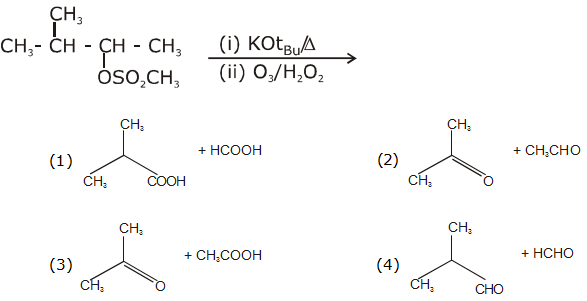
12. The major product of the following reaction is:
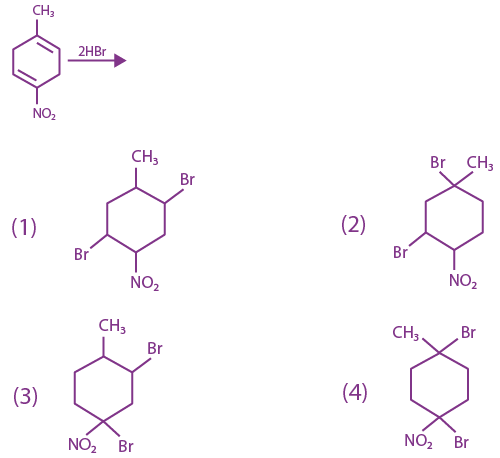
13. The increasing order of pKb values of the following compounds is:
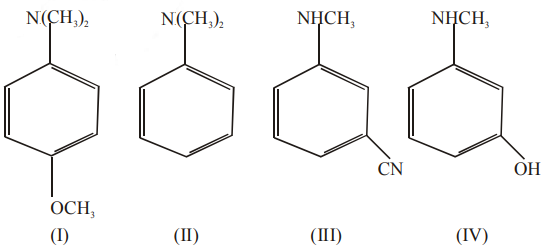
(1) I < II < III < IV
(2) II < IV < III < I
(3) I < II < IV < III
(4) II < I < III < IV
14. kraft temperature is the temperature :
(1) Above which the aqueous solution of detergents starts boiling
(2) Below which the formation of micelles takes place.
(3) Above which the formation of micelles takes place.
(4) Below which the aqueous solution of detergents starts freezing.
15. The set that contains atomic numbers of only transition elements, is?
(1) 9, 17, 34, 38
(2) 21, 25, 42, 72
(3) 37, 42, 50, 64
(4) 21, 32, 53, 64
16. Consider the Assertion and Reason given below.
Assertion (A): Ethene polymerized in the presence of Ziegler Natta Catalyst at high temperature and pressure is used to make buckets and dustbins.
Reason (R): High density polymers are closely packed and are chemically inert. Choose the correct answer from the following:
(1) (A) and (R) both are wrong.
(2) Both (A) and (R) are correct and (R) is the correct explanation of (A)
(3) (A) is correct but (R) is wrong
(4) Both (A) and (R) are correct but (R) is not the correct explanation of (A)
17. A solution of two components containing n1 moles of the 1st component and n2 moles of the 2nd component is prepared. M1 and M2 are the molecular weights of component 1 and 2 respectively. If d is the density of the solution in g mL−1, C2 is the molarity and x2 is the mole fraction of the 2nd component, then C2 can be expressed as:
(1) ![]()
(2) ![]()
(3) ![]()
(4) ![]()
18. The correct statement with respect to dinitrogen is?
(1) Liquid dinitrogen is not used in cryosurgery.
(2) N2 is paramagnetic in nature
(3) It can combine with dioxygen at 25°C
(4) It can be used as an inert diluent for reactive chemicals.
19. Among the sulphates of alkaline earth metals, the solubility of BeSO4 and MgSO4 in water, respectively, are:
(1) Poor and High
(2) High and high
(3) Poor and poor
(4) High and poor
20. The presence of soluble fluoride ion upto 1ppm concentration in drinking water, is:
(1) Harmful to skin
(2) Harmful to bones
(3) Safe for teeth
(4) Harmful for teeth
21. A spherical balloon of radius 3cm containing helium gas has a pressure of 48 × 10−3 At the same temperature, the pressure, of a spherical balloon of radius 12 cm containing the same amount of gas will be…………………….× 10−6 bar.
22. The elevation of boiling point of 0.10m aqueous CrCl3 xNH3 solution is two times that of 0.05 m aqueous CaCl2 The value of x is……………..
[Assume 100% ionisation of the complex and CaCl2, coordination number of Cr as 6, and that all NH3 molecules are present inside the coordination sphere]
23. Potassium chlorate is prepared by the electrolysis of KCl in basic solution

If only 60% of the current is utilized in the reaction, the time (rounded to the nearesthour) required to produce 10g of KClO3 using a current of 2A is ………….
(Given: F = 96,500 C mol−1; molar mass of KClO3=122 g mol−1)
24. In an estimation of bromine by Carius method, 1.6 g of an organic compound gave 1.88 g of AgBr. The mass percentage of bromine in the compound is……. .(Atomic mass, Ag=108, Br=80 g mol–1)
25. The number of Cl = O bonds in perchloric acid is, “……………”
Mathematics
1. The region represented by {z = x + iy ∈ C : z − Re(z) ≤ 1} is also given by the inequality: {z = x + iy ∈ C : z − Re(z) ≤ 1}
(1) ![]()
(2) ![]()
(3) y2 ≥ 2 (x + 1)
(4) y2 ≥ x + 1
2. The negation of the Boolean expression p (~p ∧ q) is equivalent to:
(1) p∧~q
(2) ~p~q
(3) ~pq
(4) ~p∧~q
3. The general solution of the differential equation  is:
is:
(1) 
(2) 
(3) 
(4) 
4. Let L1 be a tangent to the parabola y2 = 4(x+1) and L2 be a tangent to the parabola y2 = 8(x+2) such that L1 and L2 intersect at right angles. Then L1 and L2 meet on the straight line:
(1) x + 2y =0
(2) x + 2 = 0
(3) 2x + 1 = 0
(4) x + 3 = 0
5. The area (in sq. units) of the region A = {(x, y): |x| + |y| ≤ 1, 2y2|x|}
(1) 1/6
(2) 5/6
(3) 1/3
(4) 7/6
6. The shortest distance between the lines ![]() and x + y + z + 1 = 0, 2x – y + z + 3 = 0 is:
and x + y + z + 1 = 0, 2x – y + z + 3 = 0 is:
(1) 1
(2) 1/√2
(3) 1/√3
(4) 1/2
7. Let a, b, c, d and p be any non zero distinct real numbers such that (a2 + b2 + c2) p2 − 2(ab + bc + cd) p + (b2 + c2 + d2) = 0. Then:
(1) a, c, p are in G.P.
(2) a, b, c, d are in G.P.
(3) a, b, c, d are in A.P.
(4) a, c, p are in A.P.
8. Two families with three members each and one family with four members are to be seated in a row. In how many ways can they be seated so that the same family members are not separated?
(1) 2! 3! 4!
(2) (3!)3(4!)
(3) 3!(4!)3
(4) (3!)2(4!)
9. The values of λ and μ for which the system of linear equations
x + y + z = 2
x + 2y + 3z = 5
x + 3y + λz = μ
has infinitely many solutions are, respectively:
(1) 6 and 8
(2) 5 and 8
(3) 5 and 7
(4) 4 and 9
10. Let m and M be respectively the minimum and maximum values of 
Then the ordered pair (m, M) is equal to:
(1) (−3, −1)
(2) (−4, −1)
(3) (1, 3)
(4) (−3, 3)
11. A ray of light coming from the point (2, 2√3) is incident at an angle 30° on the line x = 1 at the point A. The ray gets reflected on the line x = 1 and meets x-axis at the point B. Then, the line AB passes through the point:
(1) (4, −√3)
(2) (3, −1/√3)
(3) (3, −√3)
(4) (4, −√3/2)
12. Out of 11 consecutive natural numbers if three numbers are selected at random (without repetition), then the probability that they are in A.P. with positive common difference, is:
(1) 10/99
(2) 5/33
(3) 15/101
(4) 5/101
13. If f(x + y) = f(x) f(y) and  where N is the set of all natural number, then the value of
where N is the set of all natural number, then the value of ![]() is:
is:
(1) 2/3
(2) 1/9
(3) 1/3
(4) 4/9
14. If {p} denotes the fractional part of the number p, then  is equal to:
is equal to:
(1) 5/8
(2) 1/8
(3) 7/8
(4) 3/8
15. Which of the following points lies on the locus of the foot of perpendicular drawn upon any tangent to the ellipse  from any of its foci?
from any of its foci?
(1) (−1, √3)
(2) (−2, √3)
(3) (−1, √2)
(4) (1, 2)
16. 
(1) is equal to 1
(2) is equal to 1/2
(3) does not exist
(4) is equal to −1/2
17. If  (n, a > 1) then the standard deviation of n observations x1, x2, x3…xn is:
(n, a > 1) then the standard deviation of n observations x1, x2, x3…xn is:
(1) ![]()
(2) ![]()
(3) a – 1
(4) ![]()
18. If α and β be two roots of the equation x2 − 64x + 256 = 0. Then the value of  is :
is :
(1) 1
(2) 3
(3) 2
(4) 4
19. The position of a moving car at time t is given by f(t) = at2 + bt + c, t > 0, where a, b and c are real numbers greater than 1. Then the average speed of the car over the time interval [t1, t2] is attained at the point :
(1) (t1 + t2)/2
(2) 2a(t1 + t2) + b
(3) (t2 – t1)/2
(4) a(t2 – t1) + b
20. If ![]() and
and ![]() such that I2 = αI1 then α equals to:
such that I2 = αI1 then α equals to:
(1) 5050/5049
(2) 5050/5051
(3) 5051/5050
(4) 5049/5050
21. If ![]() are unit vectors, then the greatest value of
are unit vectors, then the greatest value of ![]() is ______.
is ______.
22. Let AD and BC be two vertical poles at A and B respectively on a horizontal ground. If AD = 8 m, BC = 11 m and AB = 10 m; then the distance (in meters) of a point M on AB from the point A such that MD2 + MC2 is minimum is:
23. Let f : R → R be defined as

The value of λ for which f´´(0) exists, is _______.
24. The angle of elevation of the top of a hill from a point on the horizontal plane passing through the foot of the hill is found to be 45°. After walking a distance of 80 meters towards the top, up a slope inclined at an angle of 30° to the horizontal plane, the angle of elevation of the top of the hill becomes 75°. Then the height of the hill (in meters) is:
25. Set A has m elements and set B has n elements. If the total number of subsets of A is 112 more than the total number of subsets of B, then the value of m∙n is
Latest Govt Job & Exam Updates: